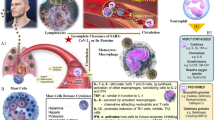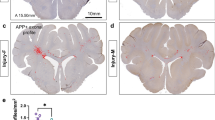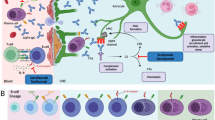Abstract
Background
In this study, our aim is to investigate the possible effects of Botulinum toxin type A administrations in the early and late periods on the brain stem.
Methods
Eighteen white New Zealand rabbits were used in this study with the subjects being divided into three groups. Group I received 0.05 mL sterile saline to the left anterior auricular muscles. Group II and III were injected with Botulinum toxin type A (Botox, Allergan) to the left anterior auricular muscles. Group II was sacrificed 5 days after application and Group III was sacrificed 12 weeks after application; brain stem tissues were then taken. The samples were examined with Caspase 3, 8, and 9 immunohistochemical stainings.
Results
In the control group with Caspase-3 immune staining, moderate-to-strong immune reactivity was seen in a small number of neurons. In the Caspase-8 and 9 immune stainings, the immune reactive neurons were seen in greater numbers when compared with the Caspase-3 immune reactive neurons. In the early and late period, groups with Caspase-8 and 9 immune stainings, the immune reactive neurons were seen in greater numbers and in the wider area when compared with the Caspase-3 immune reactive neurons. No significant differences were recognized in the Caspase immune stainings between the early and late period groups. The results were statistically supported.
Conclusion
It was concluded that Botulinum toxin type A application did not trigger apoptosis in stem cell tissues.
No Level Assigned
This journal requires that authors assign a level of evidence to each article. For a full description of these Evidence-Based Medicine ratings, please refer to the Table of Contents or the online Instructions to Authors www.springer.com/00266.









Similar content being viewed by others
References
Huang W, Foster JA, Rogachefsky S (2000) Pharmacology of botulinum toxin. J Am Acad Dermatol 43:249–259
Fatih Amato Y (2008) Botulinum toxin in medical aesthetic. J Med Sci 28:198–200
Lam SM (2003) The basic science of botulinum toxin. Facial Plast Surg Clin North Am 11:431–438
Aoki KR, Guyer B (2001) Botulinum toxin type A and other botulinum toxin serotypes: a comparative review of biochemical and pharmacological actions. Eur J Neurol 8:21–29
Dimitrova DM, Shall MS, Goldberg SJ (2002) Short-term effects of botulinum toxin on the lateral rectus muscle of the cat. Exp Brain Res 147:449–455
Turton K, Chaddock JA, Acharya KR (2002) Botulinum and tetanus neurotoxins: structure, function and therapeutic utility. Trends Biochem Sci 27:552–558
Schiavo G, Benfenati F, Poulain B, Rossetto O, Polverino de Laureto P, DasGupta BR et al (1992) Tetanus and Botulinum-B neurotoxins block neurotransmitter release by proteolytic cleavage of synaptobrevin. Nature 359:832–835
Curra A, Trompetto C, Abbruzzese G, Berardelli A (2004) Central effects of botulinum toxin type A: evidence and supposition. Mov Disord 19:60–64
Valls-Sole J, Tolosa ES, Ribera G (1991) Neurophysiological observations on the effects of botulinum toxin treatment in patients with dystonic blepharospazm. J Neurosurg Psychiatry 54:310–313
Girlanda P (1992) Botulinum toxin therapy: distant effects on neuromuscular transmission and autonomic nervous system. J Neurol Neurosurg Psychiatry 55:844–845
Carlson NR (2011) Physiological psychology. Muzaffer Ş (translation ed from 8th printing). Nobel Academic Broadcoasting, Ankara, pp 76–77
Krajewski S, Krajewska M, Ellerby LM, Welsh K, Xie Z, Deveraux Quinn L et al (1999) Release of caspase-9 from mitochondira during neuronal apoptosis and cerebral ischemia. PNAS 96(10):5752–5757
Moffitt KL, Martin SL, Walker B (2010) From sentencing to execution- the processes of apoptosis. J Pharm Pharmacol 62:547–562
Sen Mun Wai M, Liang Y, Shi C (2009) Co-localization of hyperphosphorylated tau and caspases in the brainstem of Alzheimer’ s disease patients. Biogerontology 10:457–469
Moffitt KL, Martin SL, Walker B (2010) From sentencing to execution—the processes of apoptosis. J Pharm Pharmacol 62:547–562
Krajewska M, You Z, Rong J, Kress C, Huang X, Yang J et al (2011) Neuronal deletion of caspase 8 protects against brain injury in Mouse models of controlled cortical impact and kainic acid-induced excitotoxicity. PLoS ONE 6(9):e24341
Klocke BJ, Latham CB, D’Sa C, Roth KA (2002) p53 deficiency fails to prevent increased programmed cell death in the Bcl-XL-deficient nervous system. Cell Death Differ 9(10):1063–1068
Oechmichen M, Meissner C (2006) Cerebral hypoxia and ischemia: the forensic point of view: a review. J Forensic Sci 51(4):880–887
Elmas C, Ayhan S, Tuncer S, Erdogan D, Calguner E, Basterzi Y et al (2007) Effect of fresh and stored botulinum toxin A on muscle and nerve ultrastructure—an electron microscopic study. Ann Plast Surg 59:316–322
Jabor MA, Kaushik R, Shayani P et al (2003) Efficacy of reconstituted and stored botulinum toxin type A: an electrophysiologic and visual study in the auricular muscle of the rabbit. Plast Reconstr Surg 111:2419–2426
Bulam H, Ayhan S, Sezgin B et al (2015) The inhibitory effect of platelet-rich plasma on botulinum toxin type-A: an experimental study in rabbits. Aesthet Plast Surg 39:134–140
Sibar S, Findikcioglu K, Zinnuroglu M, Cenetoglu S (2017) The effect of albümin and platelet-poor plasma supplemented botulinum A toxin on bioavailability. Ann Plast Surg 78:436–442
Popesko P, Rajtvoa V, Horak J (2003) Colour atlas of anatomy of small laboratory animals. Volume 1: Rabbit, Guinea Pig, 2nd edn. W.B. Saunders Company, London, pp 18–22
Abbruzzese G, Berardelli A (2006) Neurophysiological effects of botulinum toxin type A. Neurotox Res 9(2–3):109–114
Chen YR, Fredrick D, Steinberg GK, Liao YJ (2016) Treatment of nystagmus in brainstem cavernous malformation with botulinum toxin. Cureus. https://doi.org/10.7759/cureus.553
Matur Z, Gülşen Parman Y (2010) The use of Botulinum toxin type A in the treatment of spasticity. Arch Neuropsychiatry 47((Special Issue)):40–43
Jabor MA, Kaushik R, Shayani P et al (2003) Efficacy of reconstituted and stored botulinum toxin type A: an electrophysiologic and visual study in the auricular muscle of the rabbit. Plast Reconstr Surg 111:2419–2431
Kanter M (2008) Protective effects of Nigella sativa on the neuronal injury in frontal cortex and brain stem after chronic toluene exposure. Neurochem Res 33(11):2241–2249
Dikranian K, Qin Qin Y, Labruyere J, Nremmers B, Olney JW (2005) Ethanol-induced neuroapoptosis in the developing rodent cerebellum and related brain stem structures. Dev Brain Res 155(1):1–13
Acknowledgements
We would like to thank Dr. Bülent Çelik for the statistical analysis for the study. Mr. Edward McQuaid English Lecturer at Anadolu University (Editing).
Author information
Authors and Affiliations
Corresponding author
Ethics declarations
Conflict of interest
The authors declare that there are no conflicts of interest.
Rights and permissions
About this article
Cite this article
Seymen, C.M., Tuncer, S., Suhan Ayhan, M. et al. Botulinum Toxin Type A: Assessing The Effects on The Brain Stem. Aesth Plast Surg 42, 538–545 (2018). https://doi.org/10.1007/s00266-018-1092-3
Received:
Accepted:
Published:
Issue Date:
DOI: https://doi.org/10.1007/s00266-018-1092-3




